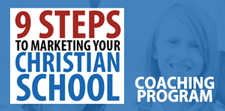
I have spoken with Christian schools across the country and have seen tuition rates range from $3500 to over $20,000 per year. But you know what is interesting about that range? Each school tells me there are families that struggle to make that payment and some prospective families who claim that the tuition is out of their price range (yes, even in the $3500/year category). Depending on the size of the town and the socio-economics of the region, some parents write the check with ease while others work extra hard to make that happen.
So what do tuition payments have to do with marketing your school? Here are 5 considerations:
- PUBLICIZE TUITION OR NOT: in a recent survey I conducted of over 60 private schools, 88% of the respondents suggested that they publish the tuition schedule on their website because they believe parents are looking for that information. The remaining 12% do not include this yet save this for the face-to-face conversation. The argument can be made both ways. As the overwhelming majority suggest, parents are likely looking for this early on in their search. But on the flip side, do you really want to “compete on price” when there are so many other factors that allow you to compete head-to-head with other schools? Putting your numbers out there may eliminate you from the search even before you have had any opportunity to visit with them in person or over the phone. Others suggest that by keeping it hidden, you may lose prospectives because they jump off your site in frustration because buyers are trained to look for price.
- PROVIDE EVIDENCE OF VALUE: if you do choose to publicize your price tag (as most school seem to), ensure that dollar figure is nestled easily inside of compelling content that demonstrates your value. Remember, parents may have “sticker shock” but it’s VALUE that they truly seek. If their need/problem/pain/frustration/fear is really high (as it relates to where they currently educate their kids), then there is no real price that is too high to solve their problem. Showcase not just the programs and offerings of your school, illustrate how these curricular, co-curricular and extracurricular activities have helped other students shine, grow, and become prepared for life after graduation. Include video, written and audio testimonials and reviews from other parents who have witnessed the value. Alumni success stories validate the price tag and offers prospective families a glimpse into their own child’s future. Some schools are focusing on how their students are walking into college with college credits which makes a nice financial argument since Dad (or Mom) won’t have to pay for as much college.
- CHANGE THE LANGUAGE: the most common way to address prospective families potentially wrestling with your school’s affordability is the word, “sacrifice”. For example, if you share in person with a prospective family (or include such language on your website or printed materials), it probably sounds like this: “many of our families make big sacrifices to come here.” While true, that’s not the best language. “Sacrifice” is a negative word because it immediately causes the prospective mom think of what she will have to give up. While sacrifice sounds noble, no one really wants to do it. There are more positive ways to put this price tag in the context of the value they will receive. Which 2 of the following 3 phrases sound better?
- Families make big sacrifices so their kids can get this quality of education. (negative)
- Families make adjustments in order to make the investment and reap the rewards they want for their kids. (challenging)
- Families choose to realign their lifestyle in order to put their child’s educational needs first. (thought-provoking)
- EDUCATE THEM ABOUT OPTIONS: if your school offers financial assistance, educate prospective parents on how this process works (assuming some of this will not be discussed until the student has been accepted). Host a workshop, webinar (see a great webinar example at Sewickley Academy) or produce easy-to-understand documents explaining how financial assistance works. Detail each step in your process, when such a review takes place, who makes the final decision, and what kinds of documentation they will need. Explain every way the family may qualify for any tuition discount (prepaid discount, multi-kid discount, military discount, etc.) If your state or school offers any other grant or scholarship opportunities, make sure prospective families know about every avenue. If you have worked a special relationship with a local bank or third-party loan company, direct parents to that possibility as well.
- REINFORCE DOUBTING PARENTS: No parents really wants to apply for assistance because they have to vulnerably expose their finances to someone they do not know. The reality is that while you are sitting there waiting with baited breath on the flow of new inquiries, some ideal families are on the other side of the proverbial mountain not sure they are willing to take that leap of faith. Cushion this reality with any relevant statistic (“50% of our families receive some form of financial assistance”). But financial assistance may not be available or necessary if parents hear from other families who have made appropriate lifestyle adjustments. Parents enter this conversation with doubt but testimonies of success can give prospective families hope that the value they will receive is more than worth it!
Sticker stock is real but does not have to stall the parents’ pursuit of a solution to their child’s educational needs. Know the concerns of your audience and prepare the path so they can discover for themselves the value you offer them.
**UPDATE**
This is a great article from Emily Cretella that shows you “How to Write a Tuition Page Worth Reading” – read it!
-Randy
PS: Do you wish you had someone to help coach and guide you through developing a customized enrollment marketing system? Click to learn how I can help.
Buffer







